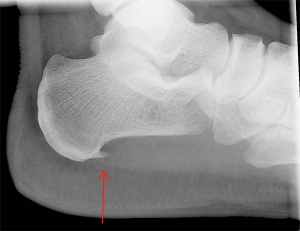An Introduction to Heel Spurs (Plantar Fasciitis)
 A common and disabling foot ailment which has a multitude of treatment options. Symptoms usually occur after rising from bed in the middle of the night, and or in the morning, but can occur after sitting down for just a few moments. Usually symptoms improve as the arch structures and calf muscle stretch to a normal functional position. This is why stretching is a hallmark of treatment. Body mass index, foot-type, shoe-wear and occupation may all be inciting factors.
A common and disabling foot ailment which has a multitude of treatment options. Symptoms usually occur after rising from bed in the middle of the night, and or in the morning, but can occur after sitting down for just a few moments. Usually symptoms improve as the arch structures and calf muscle stretch to a normal functional position. This is why stretching is a hallmark of treatment. Body mass index, foot-type, shoe-wear and occupation may all be inciting factors.
Diagnosis
Diagnosis can be made during history taking and physical examination. X-rays should be taken to rule-out other inflammatory processes, and/or injuries. X-rays may show a heel spur (Heel Spur Syndrome) but, the spur has never been proven to be the actual cause of pain.
Heel Spurs Treatments Include
- injection
- taping
- orthotics
- physical therapy
- anti-inflammatory medications
- night-splinting
- … and surgical techniques including endoscopic plantar fasciotomy
A newer treatment utilizes sound-waves to create the formation of new blood vessels at the painful area, and has been shown to be very effective. it is important to note that there are low energy sound-wave devices, that have been shown to be less effective. Make sure the device being used is the higher energy type of device for maximal outcome. The treatment is an excellent alternative to surgical intervention.



